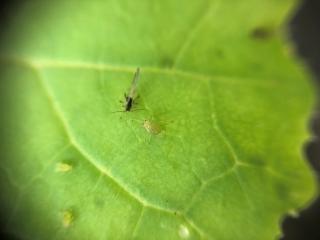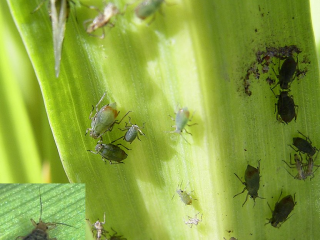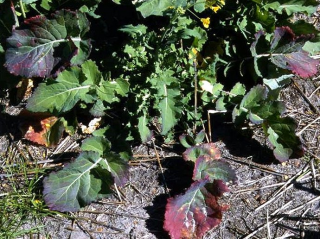Early season aphid and virus risk in cereals and canola
- Toodyay
- Nunile
- Muresk
- Kendenup
- Woogenellup
- Takalarup

This season, as part of a Department of Primary Industries and Regional Development (DPIRD) Boosting Grains surveillance project, DPIRD staff are monitoring green peach aphid (GPA) activity at certain sites in the Kwinana West, Albany and Esperance region. Yellow sticky traps have been put on fencelines to catch migrating aphids, and DPIRD staff are also conducting crop inspections and virus testing of captured aphids and inspected crops.
To date, various species of flying aphids have been caught at Toodyay, Nunile and Muresk in the Kwinana West zone, as well as at Kendenup and Woogenellup in the Albany zone. However, GPA have not been captured thus far. Oat aphid has been found colonizing grass weeds at Takalarup, so cereal crops in this area should be monitored for this species. No trapping data has been received from the Esperance zone yet.
Aphid and virus surveillance updates will be regularly shared via the PestFacts WA newsletter until crops have begun to flower and the risk of these aphid-transmitted viruses has reduced.
Impact of minimal summer rainfall on aphid populations
Aphids need non-crop hosts to survive over our long hot summer. If we don’t get a lot of summer rainfall, like this season, then aphids are often restricted to isolated damp areas like roadside ditches and home gardens.
In years where we receive substantial summer rainfall and a green bridge develops, aphids can build up their numbers to a point where, given the right cues, large numbers of them migrate into young crops during autumn and early winter. However, aphids are also greatly impacted by temperature and temperatures above 30 degrees greatly limit aphid populations and their ability to fly.
Despite the current gaps in our understanding of aphid migration dynamics, we can still make reasonably informed risk assessments by taking into account key factors such as the presence of a green bridge and temperature, along with on-the-ground data gathered from aphid monitoring programs.
Early season virus risk
Most broadacre grains viruses that infect our grains crops, particularly Barley yellow dwarf virus (BYDV) in cereals and Turnip yellows virus (TuYV) in canola, only cause significant losses when infection occurs before crop flowering. Furthermore, the risk of feeding damage by the aphid species responsible for spreading these viruses, oat or corn aphids (BYDV) and green peach aphid (TuYV), is greatest when they colonize the crop before stem elongation.
Due to the nature of our WA climate, early season spread of these viruses is relatively sporadic, and occurs under conditions that favor aphid migration from the green bridge into young vulnerable crops during autumn and early winter.
TuYV infection causes reddening, purpling or yellowing of the lower leaves of canola plants. Plants infected early (well before flowering) are often pale and stunted and these plants produce few flowers or seeds.
Symptoms of BYDV can be confused with those caused by nutrient deficiencies, waterlogging or other plant stresses that cause yellowing, reddening and striping of leaves. Leaf symptoms differ between wheat, oats and barley.
Sowing time may determine risk
Rainfall received in late March and April in many areas of the grainbelt has generated a green ramp, or green bridge, of crop volunteers (canola/ cereals), wild radish and grass weeds this season, especially on roadsides and in unsown and/or unsprayed paddock and pastures.
As many canola crops were sown not long after the first rain event of the season, they have co-developed with the green ramp. These earlier sown crops are progressing towards their mid-vegetative growth stages and are likely to be at a safer growth stage if, and when, aphids begin moving into crops and posing a risk for virus infection or early-season feeding damage.
However, crops sown more recently have been a bit slower to emerge, establish or develop in many areas due to a relatively dry past month. These later sown crops will be at greater risk from pests and pathogens building up in a more developed green ramp.
Aphids that can cause problems during the early part of the season, such as the GPA and cereal aphids are likely to be building up from a late start to their season. However, if WA growers continue to get relatively warm and dry conditions in the next six to eight weeks these aphids might begin to migrate into the later sown, and still immature, cereal and canola crops and pose a risk of virus spread and aphid feeding damage.
For more information on diagnosing and managing aphids refer to DPIRD’s Aphid management in canola crops and Diagnosing cereal aphids pages.
Management
There are a variety of management strategies that growers can employ. These range from selecting resistant varieties, delaying sowing to avoid peak autumn flights, sowing into stubble and applying foliar sprays to reduce aphid numbers.
Effective chemicals currently available in Australia for control of GPA are alarmingly limited as GPA has evolved resistance to many insecticide chemicals. For more information see GRDC’s Aphid and insecticide resistance management in grain crops.
For registered insecticide recommendations, refer to DPIRD’s 2023 autumn winter insecticide guide.
For more virus management information refer to DPIRD’s Managing barley yellow dwarf virus and cereal yellow dwarf virus in cereals and Turnip yellows virus in canola: diagnosis and management pages.
Further information
If you see aphids are colonising green bridge hosts, or you have symptomatic looking plants that you are concerned about, they can be tested for the presence of the viruses TuYV and BYDV through the Department’s Diagnostic Laboratory Services – Pathology Services.
For further information contact Research scientist Benjamin Congdon, South Perth on +61 (0)8 9368 3499.
Article authors: Benjamin Congdon (DPIRD South Perth) and Cindy Webster (DPIRD Narrogin).



